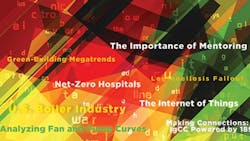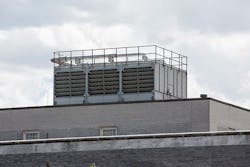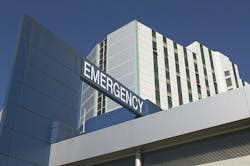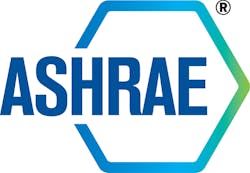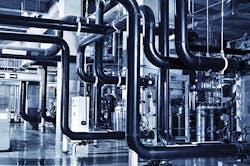Trends, Issues, and Best Practices in HVACR and Buildings 2016, Part 1
To read Part 2, CLICK HERE.
Green-Building Megatrends
By JERRY YUDELSON, PE—“Godfather of Green,” original LEED Fellow, and author of 14 books on green building
In my forthcoming book, “Reinventing Green Building: Why Certification Systems Aren’t Cutting Enough Carbon and What We Can Do About It” (New Society Publishers), I identify 10 megatrends I believe will shape green-building technologies, markets, government rules, and certification systems:
The growth rate of green-building certification is slowing.
In North America, Europe, the Middle East, and Asia-Pacific, growth in green building will continue, as more owners come to accept the business case, especially for larger office buildings, corporate real estate, and high-end university and government buildings. Growth in green-building certification, however, is slowing.
At the end of 2015, LEED certifications in the United States totaled about 3.4 billion sq ft, or only about 3.8 percent of the total 85 billion sq ft of existing commercial buildings. And only about 200 million sq ft of new construction gets LEED-certified annually. Slower growth in green-building certification in new construction does not mean important elements of sustainable design are being ignored. But certification as a practice increasingly is falling by the wayside.
Energy efficiency is leading the way.
Since 2012, we have seen greater growth in energy-efficiency retrofits than in energy-efficient new construction. This trend has been most pronounced in corporate and commercial real estate, followed by municipal, university, school, and hospital projects. There are huge opportunities in energy efficiency, with 75 percent of savings concentrated in 25 percent of the building stock, according to FirstFuel Software Inc.
Zero-net-energy buildings are on the rise.
Zero-net-energy buildings (ZNEBs) are becoming more common. A 2014 survey by the New Buildings Institute identified more than 160 ZNEBs in the United States, with an additional 53 low-energy buildings that were “net-zero-energy-capable.” Developers of speculative commercial buildings have begun to showcase zero-net-energy designs to differentiate their projects. This trend has been developing slowly since about 2011, but now seems ready to take off.
Competition among rating systems is increasing.
In the United States, LEED may see heightened competition in new-construction rating from Green Globes and possibly new entrants in specialized niches, such as retail and office interiors. In 2013 and 2014, the federal government put LEED and Green Globes on equal footing for government projects, lending further legitimacy to Green Globes. The biggest competitor to any rating and certification system, however, is the DIY (do it yourself) approach favored by many owners or the “LEED certifiable” approach, whereby LEED is used for design, but certification is not pursued.
Existing buildings are getting increased attention.
With new-construction certification basically flat, the existing-building market is getting more attention, particularly with energy-efficiency retrofits and a renewed focus on using the Energy Star system. However, LEED existing-building certification accounted for fewer than 600 buildings in 2015, or about 0.01 percent of the total U.S. nonresidential-building stock of 5.5 million buildings. This means that as more owners of existing buildings implement energy-efficiency retrofits, they are not likely to seek LEED certification.
Cloud computing and big-data analytics are providing much-needed direction.
Increasingly, building owners and third-party service companies are managing larger buildings remotely, using software platforms that provide performance monitoring, data analytics, visualization, fault detection and diagnostics, portfolio energy management, and text messaging using the cloud. For engineers, this means getting up to speed on building-data platforms and incorporating them into designs.
Cities and states are demanding building-performance disclosure.
Major cities are on board with the climate agreement stemming from the 2015 Paris Climate Conference in December. In the United States, this trend is highlighted by more than 30 large and medium-sized cities requiring—not just encouraging—commercial-building owners to disclose actual building performance to tenants, buyers, and, in some cases, the public. Such major cities as Boston, New York, Philadelphia, Seattle, San Francisco, and Washington, D.C., have such ordinances.
This will become the easiest way to monitor reductions in carbon emissions from commercial and government buildings and put pressure on owners to invest in energy-efficiency retrofits and renovations.
Debate over what constitutes healthy building materials is becoming even more aggravating.
There is little doubt the debate about healthy building products, the value of environmental-product declarations (EPDs) and health-product declarations (HPDs), and the composition of various “red lists” of chemicals of concern will expand and grow more contentious. The problem with EPDs and HPDs is that there are few accepted national consensus standards concerning the information that should be in them and how (and by whom) that information is verified.
Solar power finally is breaking through.
Solar use in buildings will continue to grow, primarily because a number of states are expected to implement aggressive renewable-portfolio standards. Solar-power growth is likely to radically alter how buildings are designed, built, and operated in the next 10 years.
Water conservation is receiving more attention.
Awareness of the coming crisis in fresh-water supply in many regions of the world will increase, as global climate change continues to affect rainfall and water-supply systems. The 2014-2015 drought in California, which saw more than 70 percent of the state experiencing extreme-drought conditions by summer 2015, brought water concerns to national attention.
For the next five years, these 10 megatrends will accelerate growth in low-carbon green buildings, the adoption of renewable energy in buildings, and water-conserving engineering designs.
Legionellosis Fallout
By LAWRENCE “LARRY” CLARK, QCxP, GGP, LEED AP+, energy and sustainability consultant, Sustainable Performance Solutions LLC
The outbreak of Legionnaires’ disease that made more than 120 people ill and claimed 12 lives in New York City during the summer of 2015 was a harsh reminder to our industry that cooling towers can pose a public health risk if not maintained properly. The outbreak came shortly after the release of ANSI/ASHRAE Standard 188-2015, Legionellosis: Risk Management for Building Water Systems, portions of which New York officials quickly adopted as law.
According to ASHRAE, Standard 188 establishes minimum legionellosis risk-management requirements for building water systems and is intended for use by owners and managers of human-occupied buildings as well as individuals involved in the design, construction, installation, commissioning, operation, maintenance, and service of centralized building water systems and components. However, it does not have all of the answers.
Standard 188 is a good road map to the answers, but it is not a panacea. It requires the development, documentation, and implementation of legionellosis control strategies, but it does not detail the specific strategies that are to be used. I think that in 2016, we will see a lot of new procedures and technologies—and perhaps some new businesses—emerging in an effort to deal with this critical issue.
The Internet of Things
By MARK KUNTZ, senior vice president, sales, marketing, operations, product strategy, and engineering, Mitsubishi Electric US Cooling & Heating
The Internet of Things (IoT) is making it possible to access HVACR systems at any time via mobile device or, in the case of larger commercial installations, advanced controls system.
From a HVAC perspective, we look at how the Internet has enabled manufacturers to make strides in efficiency and convenience. Consider equipment controls. Previously, each system in a building—HVAC, lighting, external water feature, elevator, etc.—was independent and had to be inspected separately to ensure proper operation. The knowledge gained in one system could not seamlessly be used to make the building operate smarter overall. Picture an office building closing for the night: Everyone leaves, forgetting to turn off the overhead lights. Before the IoT and Internet-based connectivity, the HVAC system’s occupancy sensor would signal that everyone had left and automatically adjust the temperature to save energy. Without such a sensor, the overhead lighting system could not communicate with the HVAC system to gain occupancy knowledge. As a result, the lights would stay on all night, wasting energy.
With modern-day controls, HVAC and lighting systems can collaborate, leading to more efficient building management. Likewise, the same building-control mechanism can operate the external water feature and elevators, among other mechanical systems. That control panel can be accessed on the facility manager’s tablet at 3:30 a.m. while he is several time zones away on vacation.
The IoT has not changed the facility manager’s role; it has increased the facility manager’s effectiveness. The IoT has enabled automated systems to work together and share knowledge, leading to smarter building operation.
For more on the Internet of Things, click here.
Net-Zero Hospitals
By TRAVIS R. ENGLISH, PE, LEED AP, CEM, chief design engineer, engineering manager, Kaiser Permanente
I am excited. I believe 2016 will be the year we truly start working toward net-zero hospitals.
There is a belief energy savings comes at the expense of indoor environmental quality. There also is a belief energy efficiency always costs a lot of money. Yet we have seen plenty of examples of low-energy and net-zero buildings—offices, schools, libraries, research centers, public buildings. These are high-quality spaces, many of them built quite cost-effectively.
Over the last two years, we have seen scattered examples of radical energy savings in hospitals. We have the technology. New thinking is emerging. Commercial buildings have shown the way. I believe we can achieve a national portfolio of low-energy and net-zero hospitals by 2030, when greenhouse-gas-reduction targets of Architecture 2030’s The 2030 Challenge are to be met. We have seen the first big steps on this road. We will see more in 2016. I am excited.
Making Connections: IgCC Powered by 189.1
By T. DAVID UNDERWOOD, P.Eng., 2015-2016 president, ASHRAE
In July 2015, ASHRAE and the International Code Council (ICC) signed an agreement outlining their roles in the development and maintenance of a new version of the International Green Construction Code (IgCC).
“IgCC Powered by 189.1” will provide the most effective way for the design and construction industry to deliver sustainable and resilient high-performance buildings.
Obviously, there is much work to be done between now and 2018. A comparison of ANSI/ASHRAE/USGBC/IES 189.1 as it stands now with the existing IgCC has been made. A committee is reviewing the differences and determining needed changes to technical content. Meanwhile, we have expanded the membership of the Standard 189.1 committee and are working on revising Chapter 1 of the IgCC within the Executive Steering Committee. Of course, you cannot bring together organizations without lots of meetings!
The full integration of ANSI/ASHRAE/USGBC/IES 189.1 to serve as the technical content of the IgCC will leverage ASHRAE’s technical expertise and increase the standard’s influence on sustainable buildings. The result will be a comprehensive compliance tool that can be used by jurisdictions worldwide that are committed to a more sustainable built environment.
The new publication also will align the USGBC’s LEED (Leadership in Energy & Environmental Design) rating-system program to ensure a streamlined and effective set of regulatory and above-code options. The LEED green-building certification program recognizes best-in-class building strategies and practices. To receive LEED certification, building projects satisfy prerequisites and earn points.
German philosopher Friedrich Nietzsche observed human connections are the “invisible threads that are the strongest ties.” Forging stronger connections among people working in the built environment is a priority for me. As president of ASHRAE for 2015-2016, my theme is “Making Connections.”
ASHRAE’s mission is to advance the arts and sciences of heating, ventilating, air conditioning, and refrigerating to serve humanity and promote a sustainable world. For us to succeed, we have to build connections. Coordinating efforts to create a more usable code to guide our industry is one of those strong connections.
The Importance of Mentoring
By GERALD J. “JERRY” WILLIAMS, PE, LEED AP, partner/senior vice president, 8760 Engineering LLC
It was the fall of 1970, and I was a first-semester graduate student in the Building Environmental Systems program at Washington University in St. Louis. I had worked for a consulting engineer doing load calculations during the summer of 1968 and done very well in an undergraduate HVAC class during my senior year. It was the first evening of ME-591, HVAC Systems and Equipment I, and I thought this simply would be a review of a lot of things I already knew; at 22, I was convinced I already possessed all of the tools I needed to be a great engineer.
I was wrong.
The course was taught by William J. “Bill” Coad, and within a few minutes, it was clear this course would be transformative for me.
In 1970, HVAC engineering was a field full of rules of thumb to be followed, load-calculation forms to be filled out, ducts and pipes to be sized, codes to be adhered to, equipment to be selected and applied, and budgets to be met. Bill Coad, however, believed the design of HVAC systems always should begin with the fundamental laws of physics and engineering. He saw the practical (and sometimes mundane) field of HVAC systems to be gloriously rich in the basics of thermodynamics, fluid mechanics, and heat transfer, and he approached every design issue with these fundamentals in mind.
We spent that first class developing the fundamental laws of psychrometrics. Our homework assignment consisted of psychrometric-process problems that needed to be solved from basic principles and without the use of a psychrometric chart. The last problem was to construct a sea-level psychrometric chart using only the Keenan and Keyes steam tables! And, thus, my journey with Bill Coad had begun.
Bill taught two of my graduate courses and acted as my thesis advisor. After graduation, I went to work for him, and over the 40 years that followed, he served as not only my employer, but my mentor, my tennis partner, and my trusted friend, gently teaching me to think as an engineer, behave as a professional, and nurture those next in line. Sharing knowledge and giving back were part of Bill’s DNA. And, not surprisingly, they became part of mine.
How did he do it? How did he act as mentor to me and so many others so effectively? I could fill many pages with remembrances of my time with Bill, but I’ll share just a few:
- Bill considered face-to-face dialog an integral part of the learning process, always taking time not only to answer my questions, but to document on a green engineer’s pad the key points we discussed and then hand the pages to me for reference. Bill always was anxious to plant seeds of knowledge and cultivate an atmosphere in which learning and growing felt good.
- Bill was incredibly good at framing and defining a problem. I would go to his office for help with a design or thought challenge, and his response always was the same: He would slide a pad of paper my way and ask me to draw a picture of the problem. He would say, “If you can’t draw a picture of the problem, you don’t yet really understand it.” But it never stopped there.
- Bill would not be content until you applied the laws of physics and engineering to solve a problem. With a completed picture in front of you, he would say, “If you can’t write an equation for the problem or process, you don’t yet really understand it.”
- In doing 1, 2, and 3 above, Bill was cultivating confidence. It always was clear he was going to accompany you on your voyage of discovery. And once a problem was solved, there was a belief the approach would work again.
- Lunches with Bill were not to be missed. Often, he would present an engineering problem that seemed simple on the surface, but, on further reflection, was not simple at all, requiring a solution obscured by the customary approach of the design community. As I said, Bill was a genius at framing problems.
- Bill believed the difference between competence and excellence in engineering was a matter not so much of technical knowledge, but of philosophy. To him, the approach to a problem was key: Building on the fundamental concepts of engineering and physics always resulted in a superior solution and sometimes led to a simple and elegant one that advanced the science of HVAC.
So, what did all of this mean for me? Looking back, I can say most of my professional accomplishments—the times I found that elegant solution, the times I pushed the envelope of our knowledge of the science of HVAC, the times the approach made all of the difference to me and the clients I served—came from seeds planted long ago by Bill Coad, many of them sown when I did not yet understand their meaning. It has been a long, exciting journey, one that started with a mentor who believed in me and was willing to share his most precious gifts of knowledge and insight for my betterment.
In 2016, how important is mentoring? I would argue it is as vital now as it was in 1970, but perhaps for slightly different reasons. Today, so much information and advice—both good and bad—is just a few keystrokes away. But what are the connections? How did technology get us where we are today? What’s really behind the problem you are trying to solve? Thus, it is not only knowledge, but insight and perspective that mentoring can furnish today. And the approach to a problem still sets apart the engineer of competence from the engineer of excellence.
Today, the qualifications for a mentoring relationship are no different than they were in 1970: someone generous in spirit who is willing to share knowledge and experience on an ongoing basis and someone teachable who recognizes the value to be obtained from such a relationship. The times and the culture have changed, but for those who strive to be the best at what they do, who are seeking that elegant solution, and who are eager to push the envelope, mentoring remains an invaluable source of insight and inspiration. And today it requires mentors who are not threatened by the amazing digital analysis techniques their mentees can utilize in solving engineering problems. These young and talented engineers need someone on whose shoulders they can stand to reach even higher. It has made all of the difference in my life as an engineer.
Boiler-Industry Challenges and Opportunities
By SCOTT LYNCH, president and CEO, American Boiler Manufacturers Association
Gazing into our crystal ball, we see challenges that have been on the horizon coming into focus, as well as some great opportunities for the boiler industry.
Workforce Development
The retirement of the baby-boom generation is happening, and companies are getting worried, so much so that the ABMA has prioritized workforce development as a key focus area for 2016 and beyond. This is not just a recruitment issue or a lack of talent in the pipeline; it also is about the loss of critical intelligence and an inability to properly train those who follow.
Changing Perceptions
Today’s boiler industry employs a highly compensated workforce using cutting-edge technology to defy laws of physics to make more energy-efficient and environmentally friendly products. But, for many, this is not the perception. The ABMA is working with its volunteer leaders to create targeted messaging focused on changing the industry’s image. This is not going to happen overnight, but we must begin to move the needle.
Manufacturing Footprint
Manufacturing of all types of boilers has taken place overseas for years, but we are reaching a tipping point as the quality of overseas parts and components continues to improve. If we want manufacturing to remain in or come back to the United States, we need to work toward leveling the playing field for U.S. manufacturing.
No One-Size-Fits-All Approach
Boilers used in industrial applications and power plants are highly engineered products built to the specific needs of the customer, while boilers installed in homes and apartments are, for the most part, stocked items. The ABMA has been working closely with government agencies and industry partners to clear up misconceptions and ensure any standard or guideline is flexible enough for adoption throughout the industry.
Analyzing Fan and Pump Curves
By KENNETH M. ELOVITZ, PE, Esq., engineering consultant, Energy Economics Inc.
When engineers select or analyze the performance of centrifugal fans and pumps, three principles apply:
- The fan or pump curve describes all combinations of flow (cubic feet per minute or gallons per minute) and head (inches of water or feet of fluid) the fan or pump can deliver.
- The system curve describes all combinations of flow and head that can flow through the system.
- The fan or pump will operate where the fan or pump curve and the system curve intersect.
The fan or pump manufacturer provides the fan or pump curve based on test data obtained from the applicable rating standard (Air Movement and Control Association International for fans, the Air Conditioning, Heating, and Refrigeration Institute Hydronics Institute Section for pumps). Data might be presented as a graph or as a table. When performance data is presented as a table (more common for fans than for pumps), plotting the data provides a picture that can aid understanding.
Centrifugal fans for HVAC applications often are belt-driven. Belt drives let a nominal-speed motor (3,500, 1,750, 1,150 rpm) drive the fan at almost any speed. Fan curves typically are presented as a family of curves that show the performance of a particular wheel size at different speeds.
Pumps for HVAC applications usually are coupled directly to their drive motors and, thus, operate at motor speed. Pump curves traditionally are presented for discrete nominal motor speeds (3,500, 1,750, 1,150 rpm) with capacity variations for a particular pump body achieved by changing impeller size. With the widespread availability and relatively low cost of variable-speed drives, pump speed no longer is restricted to discrete nominal motor speeds.
The system curve is an application of the fan/pump affinity laws:
The accompanying pump curve shows how to apply these principles. Suppose an engineer calculated a design point of 72 gpm at 25 ft of head, and the contractor supplied the Model 1632 stock pump.
Calculating a system curve from the engineer’s design point and overlaying the system curve on the pump curve predicts an actual operating point of 76 gpm at 27 ft of head.
If achieving the design 72-gpm flow is important, the contractor can throttle a valve, adding 3 ft of head at 72 gpm. The new “steeper” system curve with a characteristic of 72 gpm at 28 ft would cross the pump curve at 72 gpm.
Now, suppose an engineer went to the site and measured a pressure differential of 12½ psi (29 ft of water) across the pump. The pump curve predicts a flow of only 64 gpm instead of the desired 72 gpm. In that case, the system curve is steeper than calculated, perhaps because of field conditions or, perish the thought, an engineering-calculation error. If it is important to achieve the design 72 gpm, the contractor could replace the 5.65-in. impeller with a 6.15-in. impeller. The larger impeller would deliver the desired 72 gpm at the cost of increased pumping power. The greater pumping power would require changing the 3/4-hp motor that came with the pump to 1 hp, with a corresponding increase in operating cost.
Next month, more HVACR and buildings professionals will offer their views on industry trends and issues or provide tips and best practices to help readers get the most out of their systems in 2016.
